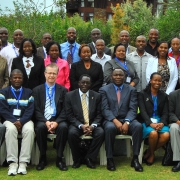A Framework to Extending Financial Inclusion throughout Africa via ICT
A report was recently released, through the eTransform Africa initiative, explaining and outlining a framework to leverage ICTs to increase financial inclusion across the continent. Written by Vital Wave Consulting and entitled eTransform Africa: Financial Services Sector Study – Sector Assessment and Opportunities for ICT, it was released as a part of a larger initiative that was commissioned by the World Bank and the African Development Bank (and supported by the African Union) to explore how ICTs can improve business models in key sectors in Africa. The sectors include: agriculture, climate change adaptation, education, health, ICT competitiveness, public services, trade and regional integration, as well as a report on cross-cutting issues.
The goal of each sector report is to share knowledge and provide an actionable framework for how ICT can be utilized by traditional and new organizations in the for-profit and social sectors, including African Governments themselves and members of the international development community.
For the Financial Services Sector Study, the creators of the report decided to focus specifically on how ICT can improve financial inclusion. This focus was driven by the fact that less than 20% of households in Africa have access to formal financial services. The reason for these low numbers includes the high percentage of population who live rural regions, poor transportation infrastructure, and limited communications infrastructure.
Opportunities and Challenges
The report identifies three major challenges areas to the utilization of ICT to expand formal financial services to the unbanked: 1) Consumer/End User, 2) Governing/Regulatory, and 3) Market Maturity and Underpinning Infrastructure.
For “Consumer/End User”, the challenges include: transient and remote populations; understanding of consumer needs; general and financial literacy of consumers; increasing trust in banking institutions; and, small and medium enterprise (SME) access to capital. In order to combat these challenges, the report states that initiatives have already started which include mobile payment systems, the development of products specifically for the local consumer, and innovative solutions to expanding capital to SME.
For “Governing/Regulatory”, the challenges are: lack of identification documents; moveable assets; fragmented collateral data; and, corruption. Currently there is a push to battle these challenges by increasing identification through SIM registration and developing collateral registries.
Finally, for “Market Maturity and Underpinning Infrastructure”, the challenges are focused around: the implementation and use of IT banking information systems in microfinance institutions (MFI) and high interest rates. To solve these challenges, the report states that SaaS (Software-as-a-Service) can be utilized to cut down IT costs and increasing the amount of credit bureaus can offer lower the interest rates offered to members.
Recommendations
Given the goal of the report to assist government agencies, policy makers and donors – the recommendations were classified into two areas: 1) Market Maturity and 2) Addressing the specific challenges listed above (by consumer, government, and private sector). Since Africa is such a diverse region – with wide variance in terms of culture, socio-economics, governmental structures, and infrastructure – the authors smartly classified their recommendations. Government agencies and donors can locate the appropriate segment and then seek the relevant advice.
The authors created three segments – or categories – to classify recommendations based on degree of market maturity: 1) Formative State (new and developing market with limited adoption and competition), 2) Scaling State (adoption rates starting to pick up and regulation being implemented in order to generate competition), and 3) Desired State (mass adoption of products/services and a competitive environment). Agencies and donors then can see which opportunities are available in their current state to increase financial inclusion, such as: mobile banking, product diversification, identification, SME access to capital, backend systems, credit bureaus, and collateral registries. It gives them a framework to analyze their current financial services industry and access where the gaps of inclusions are.
While the policy recommendations focus on how governments should move forward strategically in each country, the donor recommendations focus on these actors’ greatest resource – money. The donor recommendations use a similar structure (formative, scaling, and desired states), but there were a few opportunities that continue to show up throughout the research. These include: “reducing private sector risks by underwriting the risk of ‘first mover,’ reducing shared costs by underwriting supporting systems that are common among all financial service players, and leveraging limited donor resources to drive private and consumer action towards desired financial service sector goals.”
A Must Read
This report is a great read, especially for those who are interested in how ICT can be leveraged in financial services in developing countries. The report’s appendixes are especially interesting as they include extensive information about policies and products currently in use in mobile banking throughout the continent.
But, the best aspect of the report is that the authors truly understand the complexity of both the financial services sector and the diversity of African nations. Having read and written about many similar reports, there seems to be a lack of understanding that there are countless variables that must be accounted for when providing recommendations. Simply because an idea or best practice worked in one region does not mean it is the universal truth.
Vital Wave Consulting did a great job developing a framework for government agencies and donors, who are both experts on the regions, to analyze their own markets and see which opportunities they have not taken advantage of yet or where the possible challenges are. Instead of giving detailed advice, the report builds a framework for government agencies and donors to analyze their markets and gain insight into how ICT can improve financial inclusion in their country.







































